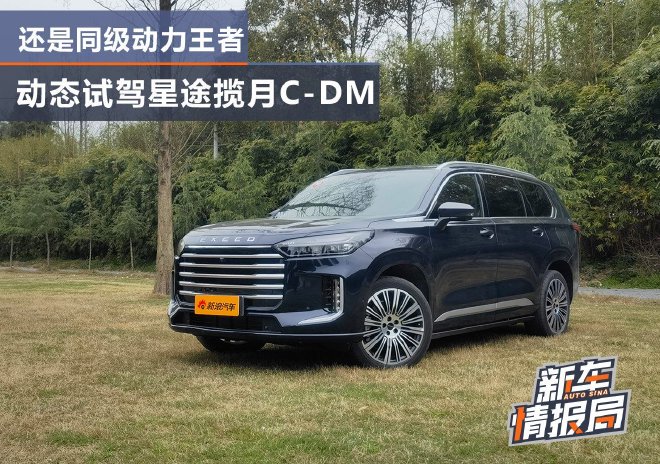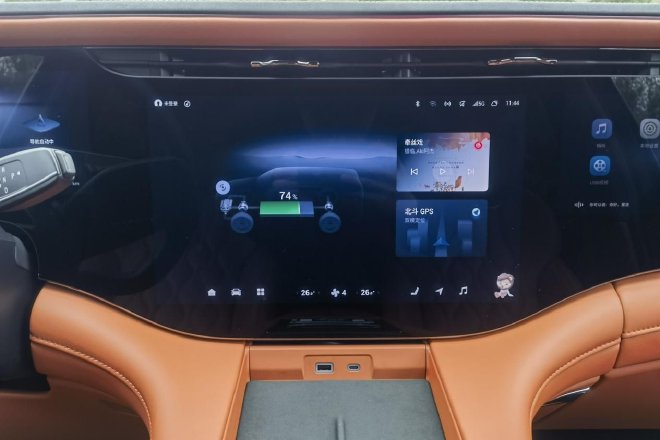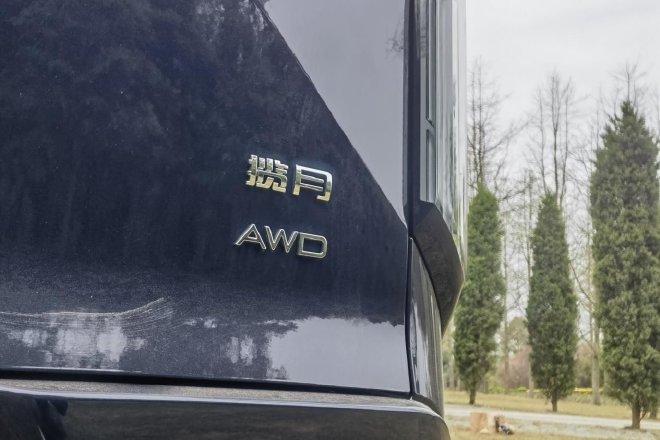A few years ago, domestic brands launched new luxury brands to create high-end models. Today, Xingtu stands out both at home and abroad. This brand, born from Chery Group, maintains its original style. It showcases Chery’s latest technology in its models. A brand built on technology will have a strong image. As an early member of the brand, the Xingtu Lanyue represents its image well. In the era of new energy, it has also refreshed its value. On March 27, the Xingtu Lanyue C-DM launched with two configurations priced between 209,900 and 239,900 yuan (32900$). As the flagship of Xingtu’s new energy line, how does it feel to drive? It retains the look of the fuel version.
The new model features added power. It retains the design of the gasoline version. The overall silhouette remains unchanged. The design emphasizes a stylish and elegant look.
The new fuel version of the Langyue, after the facelift, gains consumer approval. The C-DM model continues this design. The front features an octagonal grille with five horizontal chrome bars. The upper grille integrates a starry LED light strip for a continuous effect. Vertical fog lights on each side enhance its grand style.
The new car measures 5010mm in length, 1940mm in width, and 1800mm in height. Its wheelbase is 2900mm. Compared to the fuel version, the new car is 40mm longer and 8mm taller. These dimensions ensure ample interior space.
The rear of the car differs significantly from the fuel version. The tail lights extend downward with a forked design. The license plate area moves to the lower bumper. It features a hidden exhaust design. Additionally, the left lower corner of the tailgate adds C-DM and AWD badges to highlight its identity.
The new wheel hub enhances the premium feel. The wheels feature new high-performance tires from the Continental MC6 series, sized 245/45 R20. This setup improves handling and braking performance. Cockpit: Technology takes center stage.
The cabin design follows the style of the fuel version. It only makes adjustments in some details. The floating IP features a large screen and a horizontal dual-spoke steering wheel, creating a tech-savvy look. Specifically, the center console includes a 12.3-inch full LCD instrument cluster, a 15.6-inch central screen, and a 12.3-inch passenger entertainment screen. This trio serves as the visual and human-machine interaction center of the cabin.
The screen displays clearly. The car features the Lion 5.0 smart system and the Qualcomm Snapdragon 8155 chip. The digital AI cockpit showcases various applications. HiCar, CarPlay, Gaode Map Lion version, and iQIYI integrate seamlessly. Touch controls operate smoothly. AI voice control responds quickly and supports many functions.
In the realm of intelligent driving, under Chery’s strategy for full intelligence, new cars come standard with Falcon Intelligent Driving. In May, they will launch the NOA highway navigation assistance feature online. This will enable true high-level intelligent driving across nearly 140 cities nationwide. Our test vehicle is an engineering prototype, so we cannot yet experience it. Additionally, features like APA full automatic parking, HPA memory parking, and FTBA trace-back parking significantly enhance the smart parking experience.
The cabin acoustics impress. The audio system features high-end specifications. Lion Melody boasts a 7.1.4 channel surround sound with 23 speakers and a driver headrest. It uses dual-core DSP processing technology and includes a separate amplifier. Passengers enjoy excellent sound quality throughout the journey.
The new car features first-class seats covered in NAPPA leather. It includes suede headrests. The front seats offer heating, ventilation, and massage functions as standard. The passenger seat has a long leg rest and also provides a massage function. Sitting here delivers a comfort experience that surpasses the driver’s seat. The flagship design impresses with no flaws.
The details have changed. The front center armrest now holds the cup holders horizontally instead of vertically. This prevents confusion between the driver and passenger drinks. The USB and TYPE-C ports moved below the central screen. Below them, two 50W wireless charging panels provide more convenience.
The new car offers 6-seat and 7-seat versions. The official data shows that the second-row legroom reaches 901mm. In the 7-seat model we tested, the second row slides forward and backward. The backrest also adjusts to a large angle. Passengers can easily find a comfortable seating position.
The third row offers more than just makeshift seating. At 178 cm tall, I find ample legroom after adjusting the second row. I can stretch my legs comfortably. It truly delivers on “every seat enjoys comfort.”
The third-row seats also support electric folding and unfolding. The button panel is located on the left side inside the trunk.
The trunk can hold several 20-inch carry-on suitcases. The third-row seats fold flat to expand space. Our seven-seater model also allows the second-row seats to fold 4/6. This creates a nearly flat, oversized floor. You can load large items or use it as a bed for camping. It remains the best in its class for power.
The Langyue C-DM features the world’s first C-DM four-engine four-wheel drive hybrid technology. It uses a 1.5TGDI hybrid engine with a thermal efficiency of 44.5%. The engine delivers a maximum power of 115 kW. The front P2 and P2.5 dual drive motors provide a maximum power of 165 kW. The rear P4 motor reaches a maximum power of 175 kW. The system combines for a total power of 619 PS and a total torque of 920 N·m. A 3-speed DHT manages the power. The car accelerates from 0 to 100 km/h in 5 seconds. The WLTC fuel consumption is 6.88 L/100 km.
The new car features a standard 34.46 kWh M3P lithium iron phosphate battery from CATL. It includes the Chery MANA-Q battery management system. The battery excels in waterproof, impact-resistant, and heat-resistant performance, surpassing national standards. In terms of range, the car offers a CLTC pure electric range of 180 km. Its total range exceeds 1300 km. It can efficiently recharge from 30% to 80% in 22 minutes. The car also supports a 6.6 kW external discharge power, ensuring reliable camping.
Once you start driving, you quickly feel the system’s strong response to the pedals. The motor provides ample power. At first, it feels gentle and pleasing for passengers. However, apply slight pressure on the accelerator, and the speed rises rapidly. Power surges quickly afterward. At traffic lights, few cars can match its performance.
The C-DM system focuses on economic output. The engine starts working at a speed of 16 kilometers per hour. On urban expressways, the three-speed DHT diligently coordinates the engine and motor. Its operation remains smooth, with minimal shift perception. Overall, it follows the same logic as a traditional fuel vehicle’s transmission. It aims to optimize the engine’s characteristics for better fuel efficiency.
In the mid-range acceleration, you won’t worry about power output. The motor and engine work together. They respond quickly. At mid to high speeds, just press the gas, and the response is sharp. You always have power ready. You won’t feel a delay when you need to accelerate.
The new car offers six driving modes: economy, standard, sport, snow, sand, and off-road. The power system works hard to meet your demands in any situation. I really like the sport mode. If you press the accelerator, it responds well. You can accelerate even near the speed limit. This powertrain feels like it has plenty of potential. Calling it a “big cannon” is perfectly fitting.
The model we test drove features the Snow Leopard four-wheel drive system. This electric four-wheel drive prioritizes a premium driving experience. It handles rough unpaved roads with ease. Its response speed surpasses that of typical on-demand four-wheel drives. Efficiency also improves, and torque distribution broadens. Thanks to this system, the car avoids the common issue of “slipping at start” seen in many performance vehicles. It maintains stability in various road conditions.
The entire lineup features the Flying Fish super-sensitive chassis. Its electromagnetic variable damping shock absorbers undergo exclusive tuning. The all-aluminum alloy H-arm multi-link rear suspension works with the dual hydraulic mounts and HDS hydraulic isolation system. The hardware is robust. Engineers fine-tune the chassis multiple times. Commuting on smooth city roads reveals a rare sense of luxury. Even on rough surfaces, it maintains some road feel. This sensation evokes a term: “German flavor.”
The steering wheel damping feels light. It gains linearity with speed. This design prevents the struggle between you and the steering wheel in corners. The longer suspension travel provides just the right amount of play in the steering. The car feels stable. It scores high in handling compared to its rivals. Driving it is easy. In summary, new energy models from domestic mid-to-high-end brands often serve as flagship models. The Xingtu Lanyue C-DM is no exception. The C-DM enhances performance efficiency. Upgrades in appearance and features make it more comprehensive. Overall, it can compete with joint ventures in the same class. It also matches the capabilities of similarly priced products. Its premium nature is not just talk.

























